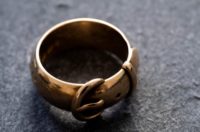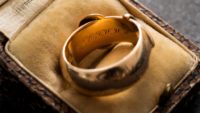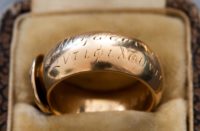 An 18-carat-gold inscribed gold ring that was a gift from Oscar Wilde to a friend during his undergraduate days at Magdalen College in Oxford will be returning to its alma mater 17 years after it was stolen.
An 18-carat-gold inscribed gold ring that was a gift from Oscar Wilde to a friend during his undergraduate days at Magdalen College in Oxford will be returning to its alma mater 17 years after it was stolen.
The inside is engraved “O.F.O.F.W.W & R.R.H. to W.W.W., 1876,” the initials of gifters and receiver: Oscar Fingal O’Flahertie Wills Wilde, Reginald Richard Harding and William Welsford Ward, respectively. The three were close friends as undergraduates in Magdalen’s classics program. Ward was a year ahead of Wilde and he sort of took him under his wing, introducing him to his friends, to Freemasonry, going on rides through the woods where they argued about philosophy so vigorously that Wilde often fell off his horse. It was Ward, known as “Bouncer,” who introduced him to Harding, aka “Kitten.” Wilde’s nickname in this crew was “Hosky.”
Ward took his final exams in November 1876 and while he did well, he did not receive the First he expected. Instead of returning to Oxford as a fellow, Bouncer decided to go walkabout and travel to Italy. Hosky and Kitten had the friendship ring made as a memento of their happy trio. The inscription on the outside read in Greek: “Gift of love, to one who wishes love.”
 The ring was part of the extensive collection of Oscar Wilde memorabilia held by his alma mater, Oxford University’s Magdalen College. It was stolen in the wee hours of Thursday, May 2nd, 2002, by one Eamonn Andrews aka Anderson, a former Magdalen cleaner and handyman who, fortified with copious quantities of whisky downed at the college bar, broke into the Old Library through a skylight on a drunken mission to find evidence his estranged wife, the head gardener at Magdalen, had had an affair with another man.
The ring was part of the extensive collection of Oscar Wilde memorabilia held by his alma mater, Oxford University’s Magdalen College. It was stolen in the wee hours of Thursday, May 2nd, 2002, by one Eamonn Andrews aka Anderson, a former Magdalen cleaner and handyman who, fortified with copious quantities of whisky downed at the college bar, broke into the Old Library through a skylight on a drunken mission to find evidence his estranged wife, the head gardener at Magdalen, had had an affair with another man.
At some point he broke in, this harebrained half-scheme got even more stupid and morphed into the incredibly random theft of two rowing medals — the 1910 Henley Royal Regatta Grand Challenge Cup medal and a 1932 silver and a bronze medal. The alarm sounded but while the college porter was investigating, Andrews stole the gold ring from a display cabinet in another part of the college.
DNA analysis of blood traces found at the scene of the crime led to the arrest and incarceration of Andrews. He admitted his culpability and described the theft as an impulse, not premeditated or even a tiny bit thought through. He claimed he had no idea of the objects’ value and had sold them to a London scrap dealer for £150. He was sentenced two years in prison for the theft, to be served concurrently with the six years he had begun to serve for an earlier robbery.
Magdalen kept the news of the theft quiet in the beginning, hoping police would be able get the artifacts back. A week later, they announced the loss of the ring and offered a £3,500 reward, the equivalent of a tenth of its insured value, for any information leading to the its return. None was ever forthcoming.
 More than a dozen years passed, and the ring was feared melted down. In 2015, Dutch art investigator par excellence Arthur Brand heard some scuttlebutt on the mean streets that a gold buckle-shaped Victorian ring with a “Russian” inscription had surfaced in the black market. Brand recalled the theft of the unusual Wilde ring and wondering if that “Russian” writing might actually be Greek.
More than a dozen years passed, and the ring was feared melted down. In 2015, Dutch art investigator par excellence Arthur Brand heard some scuttlebutt on the mean streets that a gold buckle-shaped Victorian ring with a “Russian” inscription had surfaced in the black market. Brand recalled the theft of the unusual Wilde ring and wondering if that “Russian” writing might actually be Greek.
The Dutchman then started to put out feelers.
Together with a London-based antiques dealer named William Veres, their enquiries eventually led them to George Crump, a man whom Brand described as a “decent man with knowledge of the London criminal underworld because of his late uncle, a well-known casino owner.”
Through Crump, Brand and Veres finally managed to track down and negotiate the safe return of the stolen ring.
It’s possible the ring only surfaced because it was stolen AGAIN, this time in the Hatton Garden safe deposit burglary, at an estimated £200 million in jewelry stolen the largest burglary in English history. That burglary, perpetrated by a gang of septuagenarians, took place in April 2015 and after that gossip was rife in the demimonde that a bunch of previously stolen goods had been found in the vault.
The ring is now in a secure location in England. It will be officially returned to Magdalen College in a ceremony at Oxford on December 4th.